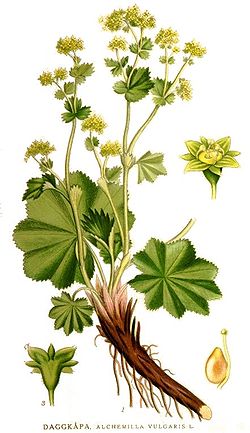Lady’s Mantle. Alchemilla vulgaris
 Also Known As:
Also Known As:
Lion's
Foot, Manto de la Virgen, Nine Hooks, Nueve Ganchos, Pie de León, Silerkraut.
CAUTION:
See separate listing for Alpine Lady's Mantle.
Scientific Name:
Alchemilla
xanthochlora; Alchemilla vulgaris.
Family:
Rosaceae.
People Use This For:
Alchemilla
is used for mild diarrhoea, heavy menstrual flow, diabetes, menopausal
complaints,
painful menses, gastrointestinal disorders, as a relaxant for muscle spasms, an
anti-inflammatory, a diuretic, and as a garglefor mouth and throat inflammation.
Topically,
alchemilla is used as an astringent for bleeding, to improve wound healing, for
ulcers, eczema, skin rashes, and as a bath additive for treating lower-abdominal
ailments.
Safety:
Alchemilla
has been used for many years without reports of significant toxicity (2, 3, 4).
No
scientific studies have been carried out for topical use of alchemilla.
Pregnancy:
There are no scientific studies available. A 2012 pharmaceutical review assessment
describes it as safe in pregnancy
Breastfeeding:
There are no scientific studies available.The above review has no comment for
avoiding or for indications for use.
Effectiveness:
There is
insufficient reliable information available about the effectiveness of alchemilla.
Mechanism of Action:
The above
ground parts are used. Alchemilla contains 6-8% tannins (3), which are likely to account for
its perceived astringent activity (2). A water extract of Alchemilla xanthochlora
demonstrates lipid peroxidation and superoxide anion scavenging activity (2). Flavonoid extracts inhibit
proteolytic enzymes, including elastase, trypsin, and alpha-chymotrypsin. This
property suggests alchemilla might have a role in protecting conjunctive and
elastic tissues (2).
Adverse Reactions:
Although
one reference refers to an association with liver damage no cases have
been
reported and the association is likely to be spurious (3).
Interactions with Herbs & Supplements:
None
known.
Interactions with Drugs:
None
known.
Interactions with Foods:
None
known.
Interactions with Lab Tests:
None
known
Interactions with Diseases or Conditions:
None
known
Dosage/Administration:
Oral: For
diarrhoea, a typical dose is one cup tea, prepared by steeping 1-4 grams above
ground parts in boiling water for 10 minutes and then straining (3), used up to three times per day
between meals. The average amount used per day is 5-10 grams. Equivalent
preparations can also be used (1). Diarrhoea
persisting for more than 3-4 days should be medically evaluated (3).
Topical:
No typical dosage.
Specific References: LADY’S MANTLE
1. Blumenthal
M, ed. The Complete German Commission E Monographs: Therapeutic Guide to Herbal
Medicines. Trans. S. Klein. Boston, MA: American Botanical Council, 1998.
2. The
Review of Natural Products by Facts and Comparisons. St. Louis, MO: Wolters Kluwer
Co., 1999.
3. Wichtl
MW. Herbal Drugs and Phytopharmaceuticals. Ed. N.M. Bisset. Stuttgart: Medpharm
GmbH Scientific Publishers, 1994.
4.
McGuffin M, Hobbs C, Upton R, Goldberg A, eds. American Herbal Products
Association's Botanical Safety Handbook. Boca Raton,FL: CRC Press, LLC 1997

 Also Known As:
Also Known As: